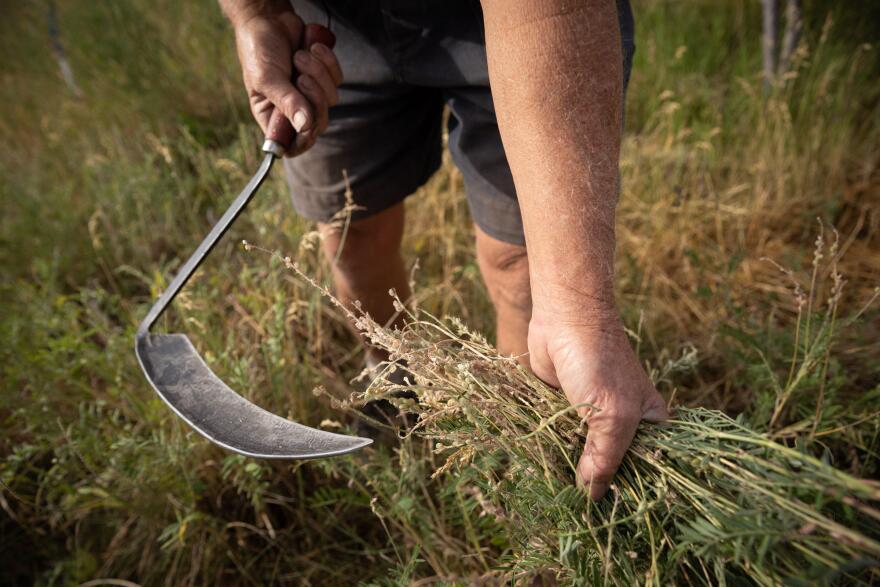Hardly a day goes by without a terrifying reminder that the earth’s climate is in crisis. The Southwest is in a mega-drought and fires are erupting around the West. But there are people working to stop climate change, including many in New Mexico.
KUNM’s Zélie Pollon talks with Santa Fe Photographer Esha Chiocchio who has created the Good Earth Project. It documents agriculturists throughout the state battling climate change by regenerating soils.
ESHA CHIOCCHIO: I wanted to tell the story of solutions -- to our land to our people to the future of humanity, we have to make some significant changes if we are going to survive.
KUNM: So tell me about soils. Why that focus? And why is soil so important?

CHIOCCHIO: There have been studies recently that say that globally, we have about 60 growing seasons left in our soils. And I don't know about you, but I have kids. And I would like to see our soils last longer than 60 growing seasons. The more I learned about soil as a climate solution, the more convinced I became that this really is one of our best mechanisms for kind of revitalizing this planet on many levels. Soil is the foundation of life, it is the most essential thing that we have. It's our most precious commodity. It's how we grow our food. It's how wildlife thrives. It adds to the diversity of this planet.
KUNM: So you worked with radio host, Mary-Charlotte Domandi, who did the interviews, and you created eight short -- and I should say truly stunning videos -- and a host of photographs. Give me a little bit more detail about each of the subjects that you interviewed.

CHIOCCHIO: Tooley's Trees is a native and drought-tolerant tree specialist, and his whole philosophy is 'no bare ground, contour the land for optimal water retention, cultivate diverse regionally-appropriate species, and encourage beneficial insects, birds and bats to frequent the land'. The next one is The Rain Catcher, the permaculture design and landscaping company in Santa Fe. And I love Reece Baker's quote, he says, 'Humans could literally be the secret to the restoration of the earth instead of the virus. The only principle you need to do is harvest the water start to grow soil. Everything will come from that, especially in the desert.' Horned Locust Goatscaping, they are regenerating landscapes with goats. So it's just a brilliant use of animal power in our urban landscapes. The next one I focused on is Reunity Resources. And they are diverting food waste, building compost, creating a farmer's market, hosting a food truck, feeding the hungry... They really exemplify a closed loop Community Food System.
KUNM: I know you also spoke with Santa Ana Pueblo, which is focusing on land restoration as a way to bring wildlife back. There's North Valley Organics in Albuquerque and they grow two crops: a cash crop and another dedicated to soil microbes. Then in Las Cruces a soil microbiologist is collaborating with a pecan farmer to transform their 30-year-old conventional pecan farm into an organic one using cover crops and integrated livestock. These projects are really amazing. And it does seem an important time to be telling their stories.

CHIOCCHIO: I think this is critical for people to understand -- not only the farmers, but also the people who are buying their food. Everyone who eats needs to know this because we have so many health problems throughout this country, many of which have been proven to be linked to these pesticides and herbicides. We're voting with our dollars, right? And so the food we buy not only can help shift the entire society from conventional agriculture to organic agriculture, but it also improves your own health.
KUNM: You're continuing to work with one of your subjects, Gordon Tooley who was asked by the state to basically reseed and create a grassland along the strip of I-10 near Lordsburg. There, the dust storms are so bad, they're the cause of 29 fatal car accidents? So he's creating these divots to kind of mimic buffalo hooves, right?
CHIOCCHIO: Each one of these pockets can hold a gallon of water. So when the rains do come, all of that water can go straight to work rebuilding the grasslands that we have lost over this past 100 years.
All eight of Chiocchio’s videos are available online. Chiocchio received a grant from the New Mexico Agriculture Department and the program has funds for farmers who are interested in rehabilitating their soils. Find out more here.



